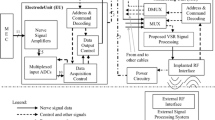Abstract
Electrical stimulation of structures within the surgical field was used to identify functional neural elements during 25 cauda equina operations. EMG responses from anterior thigh, posterior thigh, and anal sphincter muscles were recorded simultaneously using a multichannel signal averager. During nine operations, stimulation of a presumed filum terminale or other tissue produced clear EMG responses, prompting modification of surgical procedures. In one patient, this resulted in preservation of a flattened spinal cord which resembled a band of scar tissue. Some EMG responses were restricted to a single muscle group; these neural structures would probably not have been identified if only a single-channel EMG recording was used. Visual examination alone was not adequate for identifying functional neural elements, or for determining whether atretic-appearing nerve roots were functional. Electrical stimulation with multichannel EMG recording facilitates the preservation of functional neural elements and the optimization of surgical results in cauda equina surgery.
Similar content being viewed by others
References
Bassett RC (1950) The neurologic deficit associated with lipomas of the cauda equina. Ann Surg 131: 109–116
Delgado TE, Buchheit WA, Rosenholtz HR, Chrissian S (1979) Intraoperative monitoring of facial muscle evoked responses obtained by intracranial stimulation of the facial nerve: a more accurate technique for facial nerve dissection. Neurosurgery 4: 418–421
Gilmore R (1988) Use of somatosensory evoked potentials in infants and children. Neurol Clin 6: 839–859
Harner SG, Daube JR, Ebersold MJ, Beatty CW (1987) Improved preservation of facial nerve function with use of electrical monitoring during removal of acoustic neuromas. Mayo Clin Proc 62: 92–102
Hellbusch LC, Nihsen BJ (1989) Rectal sphincter pressure monitoring device. Neurosurgery 24: 775–776
Ikeda K, Kubota T, Kashihara K, Yamamoto S (1986) Anorectal pressure monitoring during surgery on sacral lipomeningocele: case report. J Neurosurg 64: 155–156
James HE, Mulcahy JJ, Walsh JW, Kaplan GW (1979) Use of anal sphincter electromyography during operations on the conus medullaris and sacral nerve roots. Neurosurgery 4: 521–523
Kimura J (1983) Electrodiagnosis in diseases of nerve and muscle: principles and practice. Davis, Philadelphia
Legatt AD (1990) Intraoperative neurophysiologic monitoring. In: Frost EAM (ed) Clinical anesthesia in neurosurgery, 2nd edn. Butterworths, Stoneham, Mass, pp 63–127
Lindsay KW, Teasdale GM (1980) Electrophysiological identification of nerve roots during operations for spinal dysraphism. Surg Neurol 14: 49–51
Macon JB, Poletti CE, Sweet WH, Ojemann RG, Zervas NT (1982) Conducted somatosensory evoked potentials during spinal surgery. II. Clinical applications. J Neurosurg 57: 354–359
Matson DD (1979) Neurosurgery of infancy and childhood, 2nd edn. Thomas, Springfield, Ill, pp 5–60
McCallum JE, Bennett MH (1975) Electrophysiologic monitoring of spinal cord function during intrapinal surgery. Surg Forum 26: 469–471
Pang D, Casey K (1983) Use of an anal sphincter pressure monitor during operations on the sacral spinal cord and nerve roots. Neurosurgery 13: 562–568
Phillips LH II, Park TS (1990) Electrophysiological monitoring during lipomeningomyelocele resection. Muscle Nerve 13: 127–132
Reigel DH, Dallmann DE, Scarff TB, Woodford J (1976) Intraoperative evoked potential studies of newborn infants with myelomeningocele. Dev Med Child Neurol 18 [Suppl 37]: 42–49
Toczek SK, McCullough DC, Boggs JS (1978) Sacral rootlet rhizotomy at the conus medullaris for hypertonic neurogenic bladder. J Neurosurg 48: 193–196
Torrens MJ, Griffith HB (1976) Management of the uninhibited bladder by selective sacral neurectomy. J Neurosurg 44: 176–185
Author information
Authors and Affiliations
Rights and permissions
About this article
Cite this article
Legatt, A.D., Schroeder, C.E., Gill, B. et al. Electrical stimulation and multichannel EMG recording for identification of functional neural tissue during cauda equina surgery. Child's Nerv Syst 8, 185–189 (1992). https://doi.org/10.1007/BF00262842
Received:
Issue Date:
DOI: https://doi.org/10.1007/BF00262842




